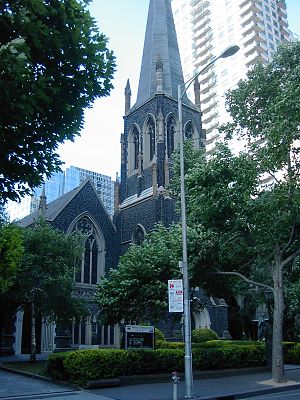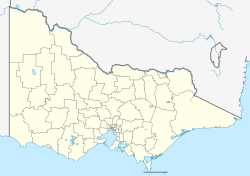Wesley Church, Melbourne
| Wesley Church, Melbourne | |
|---|---|
 |
|
| 37°48′37″S 144°58′5″E / 37.81028°S 144.96806°ECoordinates: 37°48′37″S 144°58′5″E / 37.81028°S 144.96806°E | |
| Location | Lonsdale Street, Melbourne |
| Country | Australia |
| Denomination | Uniting Church in Australia |
| Website | wesleychurch |
| History | |
| Consecrated | 26 August 1858 |
| Architecture | |
| Architect(s) | Joseph Reed |
| Style | English Gothic |
| Groundbreaking | 2 December 1857 |
| Clergy | |
| Vicar(s) | Rev. Alistair Macrae |
Wesley Church is a Uniting Church in the centre of Melbourne, in the State of Victoria, Australia.
Wesley Church was originally built as the central church of the Wesleyan movement in Victoria. It is named after John Wesley (1703–1791), the founder of Methodism. Today Wesley Church is the home of two Uniting Church congregations, the English-speaking Wesley Church, and the Chinese-speaking Gospel Hall.
In 1902, the Wesleyan Church in Australia combined with four other churches to form the Methodist Church of Australasia. In 1977, the Methodist, Presbyterian and Congregational Churches further combined to form the Uniting Church.
Wesleyans were part of the life of Melbourne from the beginning of European settlement. The first Christian worship service in Melbourne was led by Henry Reed, a businessman and Wesleyan lay preacher from Launceston, Tasmania. The first service by an ordained Christian minister in Melbourne was led by Joseph Orton, Wesleyan Superintendent of Tasmania, on 24 April 1836. Joseph Orton had been a strong opponent of slavery in Jamaica, where he was imprisoned for his views. In Tasmania, he was an equally strong critic of mistreatment of aboriginal people.
A small chapel was built in 1838, and then replaced with a larger one in Collins Street, able to seat 600 people, opened in June 1841. The organ imported for that church in 1842 is still in use in the present church.
The present Wesley Church, in Lonsdale Street was built in 1858. The Superintendent, Daniel Draper, strongly proposed a grand Gothic design with high quality architecture. This design was criticised by many Wesleyans as too ornate, too Gothic and too Anglican for a Wesleyan Church. However, Draper's design prevailed. The foundation stone was laid on 2 December 1857, and the Church was opened on 26 August 1858.
This Church was the central congregation of the Wesleyan Church for Victoria, where the Conferences met, and where ministers were ordained. It was located in a poor part of Melbourne, and pioneered many initiatives in Community Service. In the 1880s, a team of Biblewomen were appointed to work with people experiencing serious poverty. One of these was Mrs Varcoe, who established Livingstone House, a home for homeless boys in Drummond St, Carlton.
...
Wikipedia

